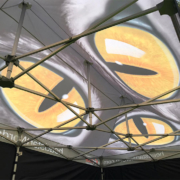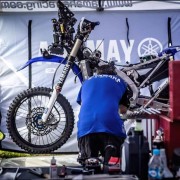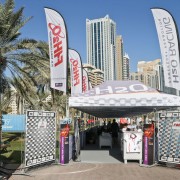screenprint or sublimationprint – what is better ?
If you are thinking of buying a folding tent, then the question may arise whether you should have this folding pavilion printed. This is less likely to be the case for private use, but if the pavilion (also called a folding pavilion, scissor tent, Ruckzuck tent, foldable tent, event tent, party tent, etc.) is required for business occasions, it is of course advisable to use the large advertising space can also be used accordingly with logos etc. Here are a few tips:
When do I use the “SCREEN PRINT(silkscreen)” printing process
The screen printing process (also known as silkscreen) is particularly suitable if several tents or roofs/sidewalls are to be printed. Screen printing – briefly explained – works in such a way that a so-called “film” is first made of the logo(s) and per color. The logo is applied to a transparent film either with a film or by laser, etc. This foil/film is then applied/burned onto the screen in a process with light. This screen usually consists of an Aluminum frame and a mesh covering. The logo is practically burned into this coated screen so that the holes in the mesh (the logo) remain open and there is a closed coating around the logo that does not let any ink through. In the printing process, the screen is then placed on the fabric to be printed and the printing ink is pressed through the screen with a “rackl” in such a way that the printing ink is pushed/transferred on to the fabric through the open net pores. The printing ink then has to dry accordingly and then bonds to the fabric. With light logo colors on dark fabrics, it is usually necessary to print several layers, i.e. the printing process is repeated 4 – 5 times as necessary until the color is opaque. Screen printing is used especially when there are larger quantities (from approx. 5 tents) and the logos have few colors (usually 1 – 2 colors). Even if, for example, the fabric should be completely black (inside and outside), then this method is suitable, as it is then practically printed on colored or solid-colored tent fabric.
Rule of thumb: The larger the number of items and the fewer printing colors per logo – the more suitable screen printing is
When do I use the “SUBLIMATION PRINT” printing process
Sublimation printing in particular has become increasingly popular in recent years. With the sublimation printing process (also called transfer printing), you first print the logo(s) or images etc. with a digital printer mirror-inverted on a special transferpaper. The ink is then allowed to dry on the paper and the printed paper roll is then clamped together with the material to be printed (only white material is possible here) in the so-called calander. The calander is a device with a drum filled with oil. The oil is heated to approx. 200°C before the printing process, so that the temperature of the drum is evenly distributed. Then the white material (fabric) to be printed is led around this oil drum together with the printed paper and then rolled up again. Due to the temperature of approx. 200°C, the ink is “burned” from the paper into the fabric, so that the ink is not only on the surface of the fabric but in the respective fabric fibers. This also provides a certain amount of scratch protection. The coating of the fabric (waterproof, water-repellent, flame-retardant) is not damaged by careful pressure and is retained. A great advantage of this printing process is that entire pictures or images can be printed on the fabric without any problems and true to life – and even in a strikingly sharp quality. Because this print only works on white fabric, the reverse side of the printed fabric remains lighter than with solid-colored fabrics with screen printing. The logos or images on the front side shine through to about 70 – 80% on the back, so that e.g. logos etc. can still be seen well on the back (mirrored). By using white fabric, lighting is particularly interesting here, as the logos or images shine outwards with appropriate interior lighting. This ensures impressive advertising even at night. So that you don’t have to set up additional rollups or folding walls and the like at trade fairs or events, printing directly on the roofs and / or side walls is also suitable. This saves you a lot of advertising material and you can use the large advertising space of the folding pavilion perfectly. A small disadvantage compared to screen printing is that – for technical reasons – the colors in the sublimation printing process fade-out more quickly than screen printing inks due to UV and other weather influences.
Rule of thumb: small number of items and larger print image as well as multi-colored logos – sublimation printing is more suitable
We would be happy to provide you with information on specific questions about your desired folding tent printing: office(at)expotradegroup.com Tel. +43 5576 73600 or www.expotradegroup.com





